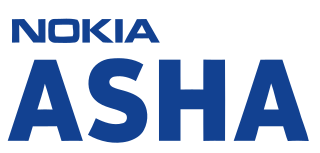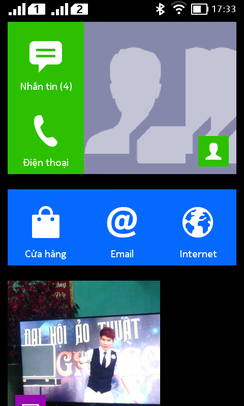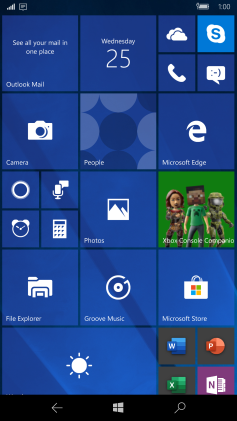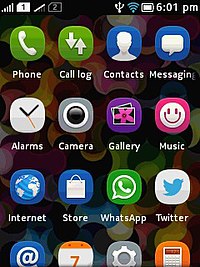
Nokia Corporation is a Finnish multinational telecommunications, information technology, and consumer electronics corporation, established in 1865. Nokia's main headquarters are in Espoo, Finland, in the Helsinki metropolitan area, but the company's actual roots are in the Tampere region of Pirkanmaa. In 2020, Nokia employed approximately 92,000 people across over 100 countries, did business in more than 130 countries, and reported annual revenues of around €23 billion. Nokia is a public limited company listed on the Nasdaq Helsinki and New York Stock Exchange. It was the world's 415th-largest company measured by 2016 revenues, according to the Fortune Global 500, having peaked at 85th place in 2009. It is a component of the Euro Stoxx 50 stock market index.
Java Platform, Micro Edition or Java ME is a computing platform for development and deployment of portable code for embedded and mobile devices. Java ME was formerly known as Java 2 Platform, Micro Edition or J2ME.
A mobile operating system is an operating system used for smartphones, tablets, smartwatches, smartglasses, or other non-laptop personal mobile computing devices. While computers such as typical/mobile laptops are "mobile", the operating systems used on them are generally not considered mobile, as they were originally designed for desktop computers that historically did not have or need specific mobile features. This line distinguishing mobile and other forms has become blurred in recent years, due to the fact that newer devices have become smaller and more mobile unlike hardware of the past. Key notabilities blurring this line are the introduction of tablet computers, light laptops, and the hybridization of the two in 2-in-1 PCs.

Windows Phone (WP) is a discontinued mobile operating system developed by Microsoft for smartphones as the replacement successor to Windows Mobile and Zune. Windows Phone featured a new user interface derived from the Metro design language. Unlike Windows Mobile, it was primarily aimed at the consumer market rather than the enterprise market.

MeeGo is a discontinued Linux distribution hosted by the Linux Foundation, using source code from the operating systems Moblin and Maemo. MeeGo was primarily targeted at mobile devices and information appliances in the consumer electronics market. It was designed to act as an operating system for hardware platforms such as netbooks, entry-level desktops, nettops, tablet computers, mobile computing and communications devices, in-vehicle infotainment devices, SmartTV / ConnectedTV, IPTV-boxes, smart phones, and other embedded systems.

Stephen Elop is a Canadian businessman who most recently worked at Australian telecom company Telstra from April 2016. In the past he had worked for Nokia as its first non-Finnish CEO and later as Executive Vice President, Devices & Services, as well as the head of the Microsoft Business Division, as the COO of Juniper Networks, as the president of worldwide field operations at Adobe Systems, in several senior positions in Macromedia and as the CIO at Boston Chicken.

The Nokia N9 is a flagship smartphone developed by Nokia, running on the Linux-based MeeGo mobile operating system. Announced in June 2011 and released in September, it was the first and only device from Nokia with MeeGo, partly because of the company's partnership with Microsoft announced that year. It was initially released in three colors: black, cyan and magenta, before a white version was announced at Nokia World 2011.

The Nokia Lumia 800, which was codenamed 'Sea Ray', is a smartphone that was launched by Nokia on October 26, 2011, at the Nokia World 2011 event. Initially, it operated on Snapdragon S2 processor and Windows Phone 7.5 "Mango" and was the first device manufactured by Nokia to run on the Windows Phone operating system. This marked a significant shift for the company from using Symbian for their smartphones. Upon its original release in November 2011 in Europe, it was Nokia's flagship product and was hence a crucial product for their mobile phone business.

Microsoft Lumia is a discontinued line of mobile devices that was originally designed and marketed by Nokia and later by Microsoft Mobile. Introduced in November 2011, the line was the result of a long-term partnership between Nokia and Microsoft—as such, Lumia smartphones run on Microsoft software, the Windows Phone operating system; and later the newer Windows 10 Mobile. The Lumia name is derived from the partitive plural form of the Finnish word lumi, meaning "snow".

The Nokia Asha series is a discontinued a range of low-end feature phones and smartphones produced and marketed by Nokia. The name "Asha" came from the Hindi word meaning "hope".

Jolla Oy is a Finnish technology company; vendor and developer of Sailfish OS. Headquartered in Tampere, Finland, Jolla has its own research and development offices in Helsinki, Tampere and Cyberport, Hong Kong. Jolla was founded in 2011 by former Nokia staff of the MeeGo project team to use the MeeGo opportunities and its "endless possibilities".
Microsoft mobile services are a set of proprietary mobile services created specifically for mobile devices; they are typically offered through mobile applications and mobile browser for Windows Phone platforms, BREW, and Java. Microsoft's mobile services are typically connected with a Microsoft account and often come preinstalled on Microsoft's own mobile operating systems while they are offered via various means for other platforms. Microsoft started to develop for mobile computing platforms with the launch of Windows CE in 1996 and later added Microsoft's Pocket Office suite to their Handheld PC line of PDAs in April 2000. From December 2014 to June 2015, Microsoft made a number of corporate acquisitions, buying several of the top applications listed in Google Play and the App Store including Acompli, Sunrise Calendar, Datazen, Wunderlist, Echo Notification Lockscreen, and MileIQ.

Maliit is an input method framework for computers with particular focus on implementing virtual keyboards. Designed mostly for touchscreen devices, Maliit allows the inputting of text without the presence of a physical keyboard. More advanced features such as word correction and prediction are also available.

Nokia Asha 501 is a low-end smartphone from the Nokia Asha series, announced by Nokia on 9 May 2013 in India, and released on 24 June 2013. The device is classified by Nokia as a "Full Touch" smartphone. The phone is available in either single- or dual SIM configuration.

The Nokia X family was a range of budget smartphones that was produced and marketed by Microsoft Mobile, originally introduced in February 2014 by Nokia. The smartphones run on the Nokia X platform, a Linux-based operating system which was a fork of Android. Nokia X is also known generally as the Nokia Normandy. It is regarded as Nokia's first Android device during the company's Microsoft partnership and was in the process of selling its mobile phone business to Microsoft, which eventually happened two months later.

Microsoft Mobile Oy was a subsidiary of Microsoft involved in the development and manufacturing of mobile phones. Based in Espoo, Finland, it was established in 2014 following the acquisition of Nokia's Devices and Services division by Microsoft in a deal valued at €5.4 billion, which was completed in April 2014. Nokia's then-CEO, Stephen Elop, joined Microsoft as president of its Devices division following the acquisition, and the acquisition was part of Steve Ballmer's strategy to turn Microsoft into a "devices and services" company. Under a 10-year licensing agreement, Microsoft Mobile held rights to sell feature phones running the S30/S30+ platform under the Nokia brand.

The Nokia X platform was a Linux-based mobile operating system and software platform originally developed by Nokia, and subsequently by Microsoft Mobile. Introduced on 24 February 2014, it was forked from Android and used on all the devices of the Nokia X family. It was also the next Nokia Linux project after the ill-fated MeeGo.

Windows 10 Mobile was a mobile operating system developed by Microsoft. First released in 2015, it is a successor to Windows Phone 8.1, but was marketed by Microsoft as being an edition of its PC operating system Windows 10.
Nokia is a Finnish multinational corporation founded on 12 May 1865 as a single paper mill operation. Through the 19th century the company expanded, branching into several different products. In 1967, the Nokia corporation was formed. In the late 20th century, the company took advantage of the increasing popularity of computer and mobile phones. However, increased competition and other market forces caused changes in Nokia's business arrangements. In 2014, Nokia's mobile phone business was sold to Microsoft.
















